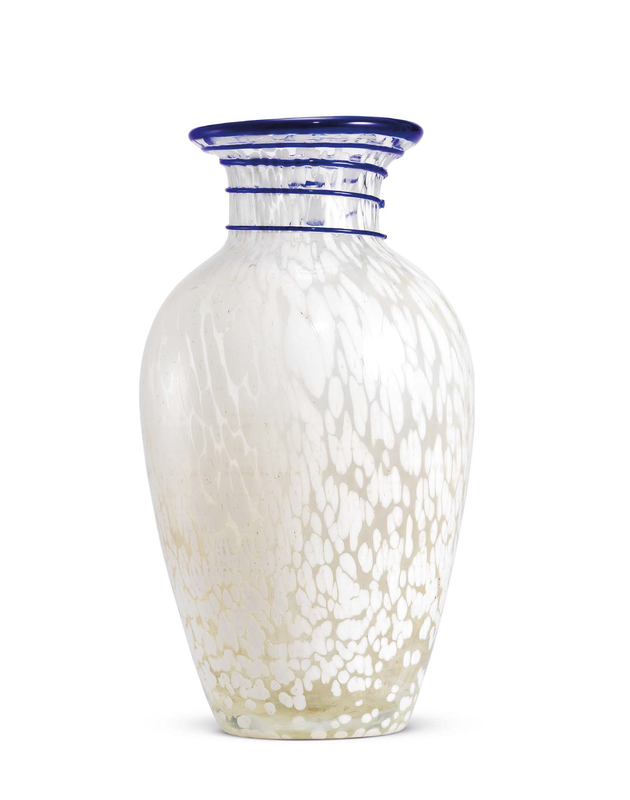Christie's. Important Chinese Ceramics and Works of Art, Hong Kong, 28 November 2018
An important and very rare Beijing glass vase, Qing dynasty, early 18th century
Lot 2934. An important and very rare Beijing glass vase, Qing dynasty, early 18th century; 10 in. (25 cm.) high. Estimate HKD 350,000 - HKD 550,000. Price realised HKD 375,000. © Christie's Images Ltd 2018.
The vase is elegantly formed with high shoulders that tapers to a sunken base. The translucent glass is decorated with opaque white splashes, below an overlay of blue swirls on the upper neck and encircling the everted mouth rim, box.
Literature: Franz Art, Chinese Art from the Hedda and Lutz Franz Collection-Glass, vol. 2, Hong Kong, 2011, pp.45, pl. 1101.
Note: The glass workshop of the Imperial Household Department was first established in 1696 during the reign of the Kangxi Emperor, and supervised by the German Jesuit missionary Kilian Stumpf (1655-1720). Lacking experienced local artisans at the inception of the glass workshop, European artisans were recruited to assist Stumpf, who also trained Chinese craftsman, as reflected in his letter to the French Jesuit headquarters in 1704, cited by Peter Lam in ‘Three Studies on the Glasshouse of the Qing Imperial Household Department’. Utilising his technical expertise and extensive glassmaking knowledge, Stumph later introduced the workshop to advanced glass formulas and forged a new practice of glass production by adopting new techniques. After Stumpf, two European glass specialists, Gabriel-Leonard de Broussard (1703-1758) and Pierre d’Incarville (1706-1757) joined the workshop in 1740, under whose supervision the making of imperial glass reached its peak until 1758 when the Jesuit management faded out.
With the introduction of new techniques in glass making, a much wider variety of colours and shapes in glassworks emerged during the early eighteenth century. Yet the present vase appears to be unique for Chinese glassware as it features blue lines trailing around the neck in threaded relief technique, which finds its roots in western practice, therefore possibly attributing the piece to Imperial glassworks. Although relatable pieces of this type can be found, the threaded design is usually worked into the clear glass ground rather than in relief.
A comparable example with opaque white striations swirling across the body, dated to the Qianlong period, is in the Beijing Palace Museum, illustrated in Luster of Autumn Water: Glass of Qing Imperial Workshop, Beijing, 2005, no. 111 (fig. 1). Another related example in the form of a flower vase with a multi-coloured stand, shows a relief threaded mouth rim in red glass, also illustrated ibid. no. 50 (fig. 2). The splashing technique seen on the present vase is more common as it appears regularly on snuff bottles, although it can also be found on a red and white speckled bowl, illustrated ibid. no. 154, where the speckles are also worked into the clear glass ground.
A Beijing glass vase, Qianlong period, Collection of the Palace Museum, Beijing.
A Beijing glass flower vase with a multi-coloured stand, Qianlong period, Collection of the Palace Museum, Beijing.

/https%3A%2F%2Fprofilepics.canalblog.com%2Fprofilepics%2F1%2F0%2F100183.jpg)
/https%3A%2F%2Fstorage.canalblog.com%2F03%2F02%2F119589%2F96711876_o.jpg)
/https%3A%2F%2Fstorage.canalblog.com%2F11%2F31%2F119589%2F94773502_o.jpg)
/https%3A%2F%2Fstorage.canalblog.com%2F20%2F83%2F119589%2F94772815_o.jpg)
/https%3A%2F%2Fstorage.canalblog.com%2F26%2F72%2F119589%2F75604929_o.jpg)
/https%3A%2F%2Fstorage.canalblog.com%2F59%2F60%2F119589%2F26458628_o.jpg)





/http%3A%2F%2Fstorage.canalblog.com%2F48%2F20%2F119589%2F129532416_o.jpg)
/http%3A%2F%2Fstorage.canalblog.com%2F63%2F64%2F119589%2F129364682_o.jpg)
/http%3A%2F%2Fstorage.canalblog.com%2F69%2F30%2F119589%2F129268894_o.jpg)
/http%3A%2F%2Fstorage.canalblog.com%2F83%2F41%2F119589%2F129150407_o.jpg)